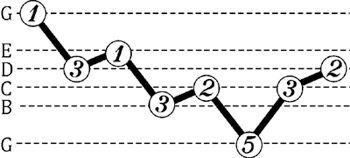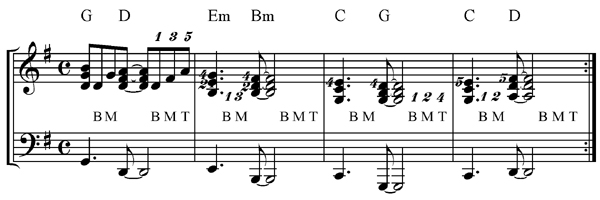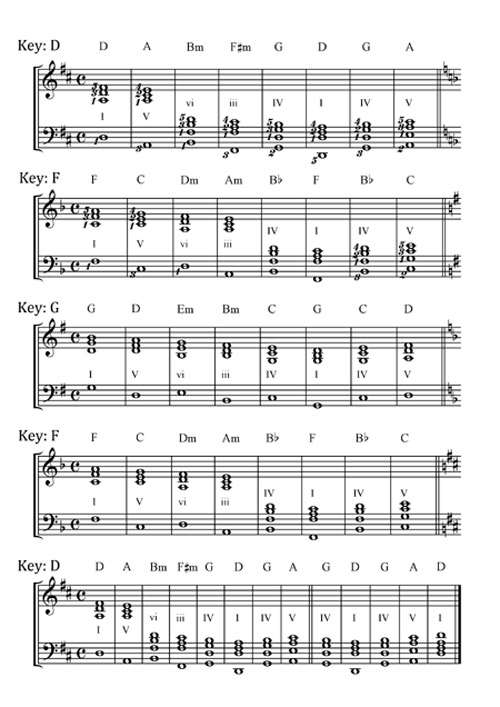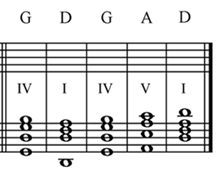The Musicarta Canon Project
Transposing the Canon Chord Sequence
- Module Three -
This is Module Three of the Musicarta Canon Project 'Transposing' mini-series. To get the most out of it, you should have worked through the main Canon Project as far as Module Seven and have finished Modules One and Two of the series (nav below).
Transposing the Canon chord sequence into G
If you look at the two strings of thirds in our original key D major and the ‘destination key’ F major in the previous section, you can see that the notes have gone up one line or one space to get into the destination key.

The notes have been transposed up a third (counting all the letter-names, D-E-F) – the distance between one line or space on the musical stave and the next line or space up (or down).. If we use the octave-down version of the thirds in F (see example), to transpose the written music from F into G we only have to move the notes from a line into the next space up, or from a space onto the next line up.

We have transposed mechanically, just by shifting the written music up from line to space (or space to line). You can always transpose this way, either on paper or in your head. remember to change the key signature.
Practice, copying the audio and MIDI performances Remember to change the key signature from one-black-key – B flat – in F major to one-black-key – F sharp – in G major.
Add a roots-only bass line to the new G major music – the original shape. Use the zigzag line diagram to find the notes without reading the music, if you can.

You can see how consistently using the same fingering helps you find the notes of the bass line. Here’s the music:

Transposing the chord sequence
To find the chords in G, use this transposing table:

If you can’t remember the Canon chord sequence in Roman numerals, read the F major Canon chord sequence into the chart to get the RNS chord symbols:

So in Roman numerals, the Canon chord sequence is:
Reading the G major chord symbols out of the chart:

Here is the music with the chord symbols (ordinary and RNS)

The Roman numeral chord symbols are written between the staves (with scale degree ‘translations’) to help you let the Roman numeral system continue to ‘sink in’. You would hope to be reading the Roman numerals fluently by now.
Right hand triads in G
Next, bring to mind what you know about the Canon right hand triads. Here is part of one of the Module Five diagrams:

Re-finger the thirds in G using just 5-3 and 4-2 and try and find the right hand thumb note.
The audio performance has the bottom notes of the right hand triads added. Try to find them before you look at the music which follows.
Here is the music showing the full triads:

A rock Canon riff
We’ll explore the more ‘rock’ potential of the Canon chord sequence in G.
First, we’ll re-write the music as four bars of minims (half notes). (You don’t have to play any faster because of the re-writing.)

Next, tap your foot and ‘anticipate’ the second minim in the bar - drag it forward one quaver slot.

Next, add some bottom/middle/top (BMT) fill-ins:

Notice how the fingering helps you get your hand onto the next chord in time.
You might decide it sounds better with the bass down an octave:

There are more BMT fill-ins in this version but only written out in the first bar. Repeat the pattern according to the BMT coding between the staves. Watching the MIDI file performance on MidiPiano will help.
The Transposing mini-series so far
If you have worked through all three Canon transposing modules thoroughly, you can play the six chords of the Canon chord sequence in three keys.
THIS IS A MAJOR ACHIEVEMENT! The ability to transpose is an essential skill for top-drawer working musicians and song-writer/composers, but most teaching systems mystify the process and leave it to much later in the course of study.
Here is a combined three-key transposing table:

In Roman numeral chord symbols, the Canon chord sequence is:
The next table shows the Canon chord sequence in the three keys we have used so far.

Here is the music for a simple three-key run-through:

The music is too small to read comfortably, but you shouldn’t need to read it. It only shows the familiar Canon chord sequence – triads in the right hand and a single bass note in the left – played in keys D, F, G, F and D again. The audio and video performance files make this clear.
The only unfamiliar part is the five-bar ending shown at the end of the video.

If you practise this three-key run-through repeatedly and regularly, you will learn to transpose. As a spin-off, you will learn and understand other chord sequences a lot more quickly and thoroughly. You will also have a much more secure foundation for improvising on the Canon chord sequence.
Click through transposing Module Four for a final Canon transposing sequence.
Thanks for visiting Musicarta.com! Come again soon!
|
OUT NOW! |
THE MUSICARTA BEAT & RHYTHM WORKBOOK At last! An effective approach to keyboard rhythm & syncopation skills. Learn more! |
ONLY $24.95! |
THE MUSICARTA
|
The MusicartaA methodical approach to keyboard syncopation for
|
PUBLICATIONS
exciting keyboard
creativity courses
CHORDS 101
WORKBOOK

~HANON~
video course

Musicarta
Patreon
PENTATONICS
WORKBOOK
video course

Creative Keyboard
video course

BEAT AND RHYTHM
WORKBOOK

- Volume 1 -

12-BAR PIANO
STYLES WORKBOOK

MUSICARTA MODES
WORKBOOK

PIANO STYLE

CANON PROJECT
video course

VARIATIONS
video course


- Piano Solo -
video course

- Piano Solo -


YouTube playlists





 THE LOGO
THE LOGO
